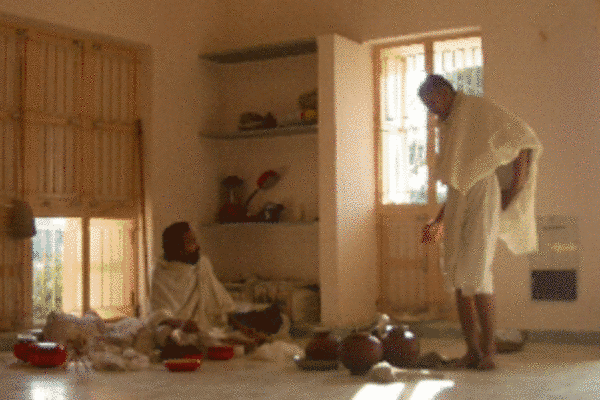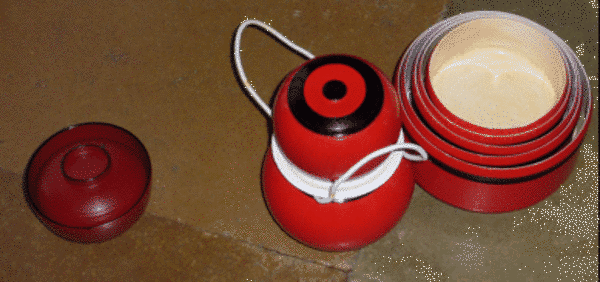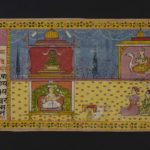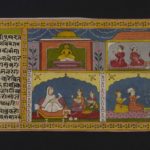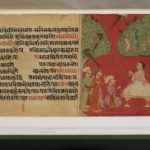Article: Monastic equipment
The items that Jain ascetics carry around are known as upadhi in earlier texts, or, more commonly, as upakaraṇa. It is important to understand that these are not possessions of the monks and nuns, because the principle of non-attachment or non-possession – aparigraha – is a crucial one for Jain mendicants. They do not own these items, which are given to them, and they aim to avoid feelings of attachment or possession towards them. These items are considered necessary for living and, in particular, for living according to religious principles.
This monastic equipment has tended to become an identity marker of asceticism. These items also mark out Digambara mendicants from Śvetāmbara ones. Even among Śvetāmbara mendicants, there are some differences in the practices of various monastic orders – gacchas. The equipment has been the starting point of numerous discussions that parallel the emergence of monastic orders in the medieval period. A vast body of literature is devoted to such topics, which are not as superficial as they may look. These sources are still being explored by scholars today.
These daily utensils are simple. But these days it is not forbidden to embellish them in various ways. Śvetāmbara nuns, in particular, may spend a lot of time in such manual activities and transform some of the implements into true artistic objects. The Terāpanthins are especially proud of this and have collected a number of such objects in the museum of the Jain Vishva Bharati, Ladnun in Rajasthan.
In all sects, the implements are normally not private or individual property. Mendicants get them from the laity. They are parts of the religious gifts – dāna – lay people can offer. Other monks or nuns can also pass on implements to their colleagues. There is a tendency, however, to consider the implements that belonged to a famous monastic figure as kinds of relics.
Inspecting the implements – Sanskrit pratilekhanā, Prakrit paḍilehaṇā – is part of the mendicant’s daily activities. There is a specific rule of behaviour which concerns carefulness in taking and putting down monastic equipment – ādāna-nikṣepa-samiti. The reason is the constant concern of non-violence. It is part of the general attitude of vigilance which a mendicant must have.
The use of the broom and of the mouth-cloth often figure in the accounts of European travellers in the 16th and 17th centuries who happened to cross the path of Jain mendicants and were amazed by them. Even now, these two implements are striking for outsider observers, who see them, often with a slightly mocking condescension, as an extreme application of non-violence.
Literary sources

Monastic teacher and pupils
Image by Victoria and Albert Museum © V&A Images/Victoria and Albert Museum, London
Monastic equipment can be seen today but it has also been described and debated in the texts down the centuries. These sources are of three kinds, namely:
- Śvetāmbara canonical scriptures and their commentaries, such as the Ogha-niryukti, or the Cheda-sūtras, which are books specifically devoted to the rules for monastic life
- early Digambara scriptures dealing with Jain monks’ way of life
- medieval and later Śvetāmbara texts in which each monastic order details the rules of monastic behaviour – sāmācārī – in force among its members, reviews points that have become problematic over time – vicāra – and discusses some of the monastic equipment, such as whether the early scriptures encourage their use and whether mendicants should carry them or not.
These texts contain technical terms and technical details of material culture. They are not always easy to understand and still need to be investigated by scholars. Concerned with the shape and characteristics of the implements, the texts distinguish between proper and improper items. These descriptions and prescriptions combine ethical considerations with more general magical concerns or superstitions. Some basic information, however, is sometimes missing. For example, these texts do not say which type of wood is used for the monastic staff.
Monastic equipment and the concept of possession
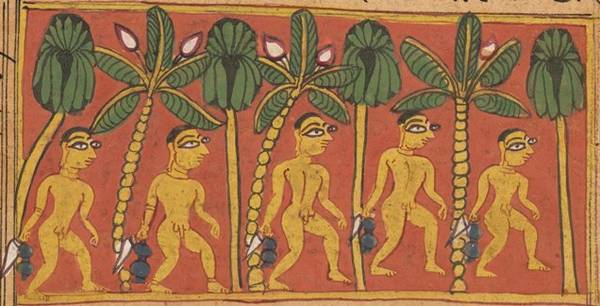
Digambara monks walking
Image by Wellcome Trust Library © Wellcome Library, London
Non-possession is the theoretical ideal of Jain mendicants and thus monastic equipment should not be thought of as items that the monks and nuns own. These monastic tools are thought to be the minimum necessary to achieving proper religious life.
The Digambaras take the idea of non-possession literally, believing that monastic equipment should never be more than the minimum. Rejecting clothes and therefore practising total nudity, achieved by their most advanced ascetics, is the most conspicuous sign of this view. The only two objects they admit are necessary are the monastic broom and the water pot.
Śvetāmbaras promote a different interpretation of possession and non-possession – for them parigraha is attachment or feeling of ownership. Thus it is not related to the number of items of monastic equipment. They are all needed for the protection of living beings and they are not ornaments. There is, however, a line between objects required permanently and those that are occasional or secondary. This line is drawn at different points by the various monastic orders, and partly accounts for the fact that the equipment varies among the main Śvetāmbara groups of Mūrti-pūjaka, Sthānaka-vāsin and Terāpanthin.
Whatever the items are, this equipment is not property as such. The newly initiated mendicant receives equipment from the laity or other monks. Even if the items carry an identifying mark, they should not become objects of psychological attachment.
Monastic equipment as identity markers
Jains see monastic equipment as outside signs – liṅga – of sectarian identity. Such attitudes are common in many religions. Lengthy debates on the validity of this or that implement are a common topic in the literature from the 14th century onwards.
While being naked or clothed is the quickest way to distinguish between monkssects of Śvetāmbara and Digambara, there are other identifying signs. The use of a begging bowl and water pot, and differences in the mouth-cloths and monastic brooms reveal monks’ sectarian identity. Within these two main groupings, the smaller sects also use equipment that marks out their monastic order from others. Items such as bookstands, staffs and seats are used by Śvetāmbara Mūrti-pūjaka ascetics.
Clothing
This has become the most obvious way to differentiate Śvetāmbara and Digambara mendicants, who form the two main Jain sectarian traditions. Śvetāmbara means ‘white-clad’ while the latter means ‘sky-clad’ – that is, naked.
However, nudity applies only to certain Digambara monks – the munis. It applies neither to their nuns – āryikās – nor to those who are not considered full monks or nuns – kṣullakas and kṣullikās. Practising total nudity is considered part of being able to renounce all possessions and live without attachment to anything. In 19th-century British India, nudity was seen as disturbing and this attitude is said to partly explain the reduction in the number of Digambara monks in that period. In today’s India this feeling is also occasionally found so that Digambara monks sometimes avoid public places in daytime. Among the Jains, however, nudity produces great respect because only those who are capable of full detachment from worldly matters can practise it in total freedom.
In Śvetāmbara early scriptures, there is some flexibility regarding the connection of clothes to the idea of non-possession. As suggested by the name, Śvetāmbara monastic robes are white. In Western Indian manuscript paintings of the medieval period, the robe of the Śvetāmbara mendicants is depicted as white or transparent with white dots. In later times, the robe is simply shown as white, as it is today.
Śvetāmbara ascetics are allowed to wear three garments – two of cotton, worn inside, and one of wool, worn on top. But the rules on clothing vary according to the status of the mendicant, the age of the texts discussing it and the practice of various monastic orders. The simple clothes are plainly stitched, then folded and wrapped around the body. The mendicants wear the complete outfit whenever they go out of their lodgings.
From time immemorial Jain mendicants have walked barefoot. In recent years, however, a minority has started wearing cotton sandals or socks. This development is usually witnessed only among aged or suffering monks or nuns, but some younger ones wear them, especially in winter in North India.
Alms bowl or begging bowl
This implement is used by Śvetāmbara mendicants to receive and eat the food donated by lay Jains. The Digambara mendicants eat directly from their hands. Hence they are known as pāṇi-pātra – ‘having hands as recipient’.
The common word used for the alms bowl is the Sanskrit pātra, which simply means ‘recipient’.
The bowls used by the Śvetāmbara monks are made of gourds, wood or clay. They are coated using sesame oil, at least in olden times (Deo 1956: 267). Today, begging bowls are generally red or dark orange. But among the Ancala-gaccha, one of the prominent Śvetāmbara Mūrti-pūjaka orders, they are black.
Bowls of different sizes can be piled up one inside the other like Russian dolls. A specific vessel for liquids can also be used. There are various articles connected with the begging bowl, such as a piece of string to use as a carrying handle. Details of these are provided in the Ogha-niryukti or Cheda-sūtras and in the scriptures.
An ornamental motif such as an auspicious symbol or a small design is sometimes painted on the bowls, for decoration. It may be used to distinguish the bowls used by different mendicants. However, according to the vow of non-possession, a bowl is not the private property of a particular individual.
Water pot
Śvetāmbara mendicants carry water or any liquid that they have received as alms in their begging bowls.
Mendicants in the Digambara tradition drink water in their interlaced fingers when receiving alms. But they also carry a special water pot containing boiled water for toilet purposes. This is usually referred to as a kamaṇḍalu.
Monastic broom
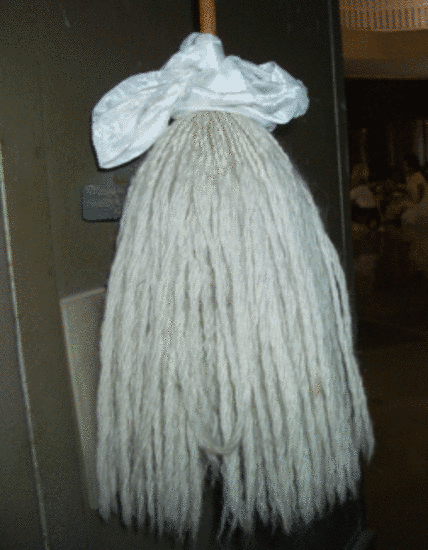
Detail of a Śvetāmbara broom
Image by Nalini Balbir © Nalini Balbir
All Jain mendicants use a broom, regardless of their monastic order. They use it in all their daily activities and it never leaves their side. This is why it is so striking for observers in the past or present. Mendicants use the broom to ‘sweep the area before sitting or lying down in order to avoid harming insects and minute forms of life’ (Wiley 2004: 177).
Śvetāmbara mendicants use a broom ‘made of long strands of soft white wool that are attached to a short wooden handle’ (Wiley 2004: 177). This is called by either the Sanskrit term rajoharaṇa or the Prakrit word oghā. The size of the broom differs among the monastic orders. Among the Sthānaka-vāsins, who do not use the monastic staff, the broom has a much longer handle than among the Mūrti-pūjakas. The latter sometimes wrap the handle in a cloth decorated with the eight auspicious symbols.
Digambara mendicants use a broom made of peacock-tail feathers, shed naturally by the birds. It is known by the Sanskrit word picchikā or its modern equivalent – piñchī. The feathers are arranged in a circle and attached to a short handle.
Mouth-cloth
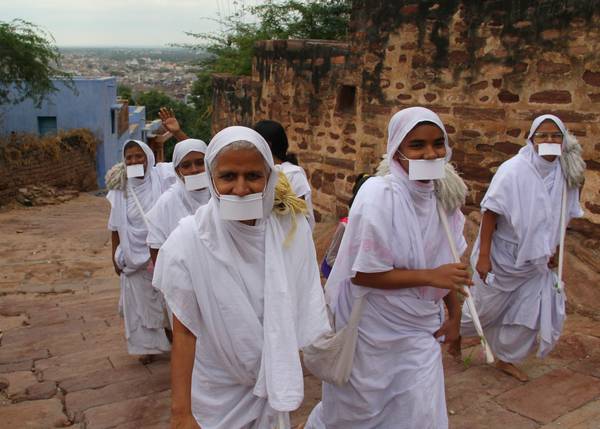
Śvetāmbara Sthānaka-vāsin or Terā-panthin nuns
Image by arjunstc – Arjun © CC BY-NC-ND 3.0
The Sanskrit word for this piece of mendicant equipment is mukhavastrikā – ‘mouth-cloth’ – but the modern form – muṃhpatti – is more commonly used. Traditionally, this is a small rectangular piece of cotton which the mendicant keeps in front of his mouth when he or she speaks.
The mouth-cloth is intended to:
- prevent minute living beings from entering the mouth and being killed or hurt
- protect wind-bodied beings, which are one-sensed living beings according to the Jain classifications of life, when breathing out.
In many paintings of ascetics the mouth-cloth is depicted as a small white rectangle, which is easily recognisable.
The way to use the mouth-covering has been the subject of several debates over time. The result is that today it has become a marker of sectarian identity.
|
Mendicant group |
Mouth-cloth usage |
|---|---|
|
When conditions indicate a need – temporary use |
|
|
Permanently covers the mouth and is fixed to the ears with strings |
|
|
Terāpanthin |
Permanently covers the mouth and is fixed to the ears with strings |
Among the Sthānaka-vāsin and Terāpanthin orders the mouth-cloth can be made of a kind of whitish plastic nowadays.
Bookstand
The term ‘bookstand’ is a convenient though partly inadequate equivalent of the Sanskrit word sthāpanācārya. It means literally ‘substitute teacher’ and is used among Śvetāmbara Mūrti-pūjaka mendicants.
The bookstand consists of four sticks of wood bound together about halfway down, which open out either side of the binding. This enables the bookstand to support its own weight and creates an empty space between the upper sticks. This space is occupied by a piece of cloth tied to each of the wooden sticks. Today five cowrie shells wrapped in cloth are tied to the stand. They represent the Five Supreme Entities – pañca-parameṣṭhin. This detail is not found in earlier times, as shown in depictions of bookstands in Jain manuscripts.
The bookstand is placed in front of the mendicant when he or she performs various religious acts, such as confession or repentance – pratikramaṇa – and is alone. It represents the absent teacher and, more generally, the whole mendicant community. During preaching, a manuscript or book is placed on it, even when the ascetic’s teacher or other mendicants are present.
Monastic staff
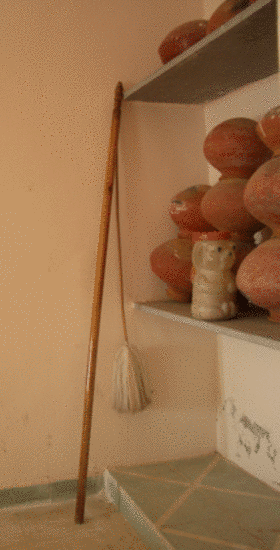
Śvetāmbara monastic equipment
Image by Nalini Balbir © Nalini Balbir
Ascetics from Śvetāmbara Mūrti-pūjaka orders carry a long wooden staff, known by the Sanskrit word daṇḍa. Mendicants in other Śvetāmbara orders, such as the Sthānaka-vāsins and the Terāpanthins, do not use a staff. Over the centuries Śvetāmbara Jains have had some debates about this implement.
In today’s practice, the staff is made of a variety of woods, particularly sīsam (Dalbergia sisoo), which is hard and long lasting. It has various shades, ranging from beige and light brown to dark brown. The top part can be decorated with a svastika, one of the most important auspicious symbols. The length depends on the mendicant’s height because when held upright the staff should reach the forehead. The staff is about 5 centimetres in diameter.
The staff was originally meant for protection. Mendicants travel only on foot and often have to cross wilderness. A passage of an old canonical Śvetāmbara scripture from the Ācārānga-sūtra describes Mahāvīra, the 24th Jina, walking among hostile people and carrying a staff as protection against dogs. He obviously did not harm anyone, but having a stick was enough to deter potential attackers.
Nowadays mendicants use the staff as a tool when walking, for instance to help estimate water depth. Since it is human height, a staff could also have been used like a gnomon, a time-measuring instrument that uses the length of shadows.
Mendicants carry the staff when they go outside, especially when begging alms. On these occasions they have to wear their full equipment. They hold the bowls in their right hand and the staff in their left. They do the same when they are wandering – vihāra.
When ascetics are in their lodgings – upāśraya – the staff is either kept outside resting on the wall or inside in a corner. It is primarily an implement for outdoors.
The top of the staff is an elaborately sculpted knob in four parts. This can be seen in manuscript illustrations. In recent times the decoration on the staff has taken on religious symbolism that makes it more than a mere practical object. Each part is understood in cosmic and doctrinal terms.
|
Part of staff |
Symbol |
|---|---|
|
small cone |
|
|
triple circle |
the three worlds or the three jewels |
|
water jug – kalaśa |
also found on Jain temples |
|
five rings |
five supreme entities or the five great vows |
This symbolism does not seem to be found in literature earlier than the 20th century but it is familiar to present-day mendicants, who pass it on orally.
Thus the staff is also a physical emblem of the Jain universe and Jain teachings.
Seats
Mendicants usually sit on the ground itself, after having checked with the monastic broom that they will not hurt any living creature by doing so.
Religious teachers of some rank use a higher seat when preaching. This is a kind of large stool or raised platform. Junior mendicants should always sit lower.
Other objects
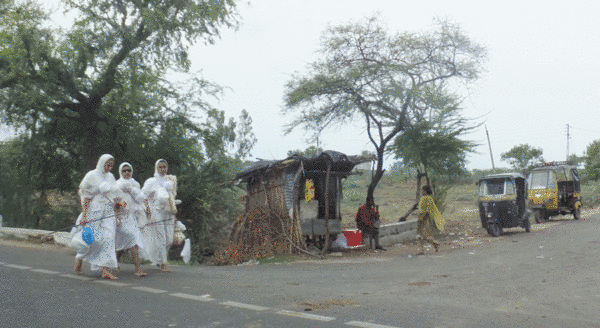
Nuns carry their mendicant equipment
Image by Sam Syverson © CC BY-NC-SA 2.0
Śvetāmbara mendicants going along the roads and carrying bundles wrapped in cotton cloth in their hands or on their shoulders are a commonplace sight in northern, central and western India. When they practise vihāra they take all their monastic equipment and other items. Apart from the usual monastic equipment, they may carry manuscripts, printed books or personal notebooks.
When these bundles are too numerous or too heavy, or when the group of walking mendicants is large, they can be carried in a small van that follows the ascetics. All these practical arrangements are made by the local lay communities.
Reading
- ‘Le bâton monastique jaina: functions, symbolisme, controverses’
Nalini Balbir - Vividharatnakaraṇḍaka. Festgabe für Adelheid Mette
edited by Christine Chojnacki, Jens-Uwe Hartmann and Volker M. Tschannerl
Indica und Tibetica series; volume 37
Swisttal-Odendorf, Nordrhein-Westfalen, Germany; 2000
- History of Jaina Monachism from Inscriptions and Literature
Shantaram Bhalchandra Deo - Deccan College Dissertation series; volume 17
Deccan College Postgraduate and Research Institute; Pune, Maharashtra, India; 1956
- Historical Dictionary of Jainism
Kristi L. Wiley - Historical Dictionaries of Religions, Philosophies, and Movements series; series editor Jon Woronoff; volume 53
Scarecrow Press; Maryland, USA; 2004
Links
- Introduction to Jainism – part 2
-
This extract from a BBC documentary called The Frontiers of Peace explores the relationship between Jain traditions and modernity. A Jain lay man tells how he reconciles his faith with his industrial business interests. A Śvetāmbara monk explains the significance of his monastic broom – known as a rajoharaṇa or oghā – including the eight auspicious symbols wrapped around the handle. A nun leads lay followers in the rite of confession – pratikramaṇa. A young woman creates auspicious symbols in rice as an offering as she talks about her decision to become a nun. This 2010 YouTube video is the second of four parts. See the next part at: www.youtube.com/watch
- Five Great Monastic Vows
-
Pravin K. Shah writes about the Five Great Vows taken by Jain monks and nuns. The information is provided by the Jainism Literature Center, associated with the Faculty of Arts and Sciences at Harvard University.
http://www.fas.harvard.edu/~pluralsm/affiliates/jainism/jainedu/5greatvows.htm
- Terāpanthin monks and nuns
-
This YouTube video shows Śvetāmbara Terāpanthin monks and nuns walking down a street in New Delhi in July 2009. Clad in white and wearing the mouth cloth – muṃhpatti – they walk barefoot, carrying their monastic equipment in bags and bundles. They are accompanied by lay Jains, many of the women dressed in orange, which is a holy colour in India. Among the monks is Ācārya Mahāprajña, the tenth ācārya or leader of the sect, who died in May 2010.
- Mahavir Aradhana Kendra – museum
-
The museum at the Mahavir Aradhana Kendra displays the equipment used by Gacchādhipati Ācārya Śrī Kailāsaāgara-sūrīśvara Mahārāj, among other exhibits. Information about opening hours, holdings and directions to the institute in Koba, near Ahmedabad in Gujarat, is on the website.
- Group initiation of Digambara monks – part 3
-
Towards the end of their group ceremony of renunciation – dīkṣā – 25 new Digambara monks have their heads anointed with sandalwood paste. The monk Vidyāsāgar, who is initiating them, traces the auspicious symbols of swastikas and four dots on their heads and palms. Then he blesses the new monks and newly initated novices – kṣullaka – who are dressed in white. He also consecrates their water pots – kamaṇḍalu. Both groups of mendicants hold their characteristic peacock-feather brooms – piñchī. Found on YouTube, this collective ceremony in Hindi took place on 21 August 2004 in the so-called Dayoday Tirth, Delwara Ghat, in the town of Jabalpur in Madhya Pradesh on the bank of the river Narmada. Watch the final part at http://www.youtube.com/watch?v=6QCfjoyWbLk
- Group initiation of Digambara monks – part 4
-
At the end of their group ceremony of renunciation – dīkṣā – 25 new Digambara monks are blessed by their teacher Vidyāsāgar. He also consecrates their water pots –kamaṇḍalu – and blesses some newly initated novices – kṣullaka – who are dressed in white. Both groups of mendicants hold their characteristic peacock-feather brooms – piñchī. The new monks have ritually taken off their clothes, which is a sign of advanced spirituality in Digambara Jainism. Then Vidyāsāgar preaches to the assembly of lay Jains. White-clad nuns – āryikā – are at the front of the crowd. Found on YouTube, this collective ceremony in Hindi took place on 21 August 2004 in the so-called Dayoday Tirth, Delwara Ghat, in the town of Jabalpur in Madhya Pradesh on the bank of the river Narmada. Watch the first part of the ceremony at http://www.youtube.com/watch?v=txYBw9ke-aU
- +
- aAbhavya
- aAbhinandana
- aAbhiṣeka
- aĀcāra
- aĀcārāṅga-sūtra
- aĀcārya
- aAchalbhrata
- aAḍhāī-dvīpa
- aAdharma
- aAdho-loka
- aAdhyayana
- aAdvaita Vedānta
- aĀgama
- aAghātīya
- aAghātīya-karman
- aAgnibhuti
- aAgra
- aĀhāra
- aAhiṃsā
- aAhimsa Day
- aAjita
- aAjīva
- aAkampit
- aĀkāśa
- aAkbar the Great
- aAkṣaya-tṛtīyā
- aAlauddin Khalji
- aAlbert Einstein
- aAllah
- aAlms
- aĀlocanā
- aAloka-ākāśa
- aAmāri
- aAmbikā or Kūṣmāṇḍinī
- aAnagāra
- aAnanta
- aAnarthadaṇḍa
- aAnaśana
- aAnekānta-vāda
- aAṅga
- aAniconism
- aAnojjā
- aAntarāla
- aAntarāya-karma
- aAṇu
- aAṇu-vrata
- aAnukampā
- aAnuprekṣā
- aAnusvāra
- aApabhraṃśa
- aAparigraha
- aAra
- aĀrambha
- aĀrambhaja
- aĀratī
- aArdhamāgadhī Prākrit
- aArhaṃ
- aArhat
- aArśana-āvaraṇīya-karma
- aĀrta-dhyāna
- aĀryikā
- aĀryikā Jñānamati
- aĀśātanā
- aĀścarya
- aAscetic
- aAsceticism
- aAshram
- aAspiration
- aĀsrava
- aAṣṭa-maṅgala
- aAṣṭāpada
- aAstikāya
- aAstrolabe
- aAsura
- aAtheism
- aAticāra
- aAtiśayakṣetra
- aAtithisaṃvibhāgavrata
- aĀtma-vāda
- aĀtman
- aAuṃ
- aAurangzeb
- aAuspicious
- aAusterity
- aAvadhāna
- aAvadhi-jñāna
- aĀvaraṇī-yakarman
- aAvasarpiṇī
- aAvatāra
- aAvidyā
- aAxiom
- aĀyāga-paṭa
- aĀyambil
- aĀyu-karma
- aĀyurveda
- bBabur
- bBāhubali
- bBaladeva
- bBālāvabodha
- bBandha
- bBasadi
- bBazaar
- bBhadrankarvijay
- bBhagavant
- bBhaktāmara-stotra
- bBhakti
- bBhale
- bBharata
- bBhāṣā
- bBhāṣya
- bBhaṭṭāraka
- bBhāva
- bBhāva-pūjā
- bBhāvanā
- bBhavana-vāsin
- bBhavya
- bBhavyatva
- bBhaya
- bBhoga-bhūmi
- bBhogopabhoga
- bBodhi
- bBollywood
- bBrahmā
- bBrahma-deva
- bBrahmacārī
- bBrāhmaṇa
- bBraj Bhāṣā
- bBright fortnight
- bBritish Raj
- bBuddha
- bBuddhi-sagar
- bBuddhism
- bBuddhist
- cCaitya
- cCaityavāsin
- cCakravartin
- cCakreśvarī
- cCāmara
- cCandanā
- cCandragupta
- cCandraprabha
- cCanon
- cCāritra
- cCāritramohanīya-karman
- cCarũrī
- cCaste
- cCaturvidha-saṅgha
- cCaturviṃśati-stava
- cCāturyāma
- cCE
- cCelibacy
- cCha
- cChadmastha
- cChastity
- cCheda-sūtra
- cChristian
- cChristianity
- cClergy
- cCloning
- cColophon
- cCommentary
- cConch
- cConfession
- cCongregation
- cConsecration
- cCosmology
- cCremation
- cCrore
- cCult
- cCūrṇi
- dDādā-guru
- dDalit
- dDāna
- dDaṇḍa
- dDark fortnight
- dDarśana
- dDarśanamohanī-yakarman
- dDaśa-lakṣaṇa-parvan
- dDeity
- dDelhi Sultanate
- dDerāsar
- dDeśāvakāśika-vrata
- dDetachment
- dDevanāgarī
- dDevānandā
- dDevarddhi-gani
- dDevotee
- dDhamal
- dDhanuṣ
- dDhāra
- dDharma
- dDharma-dhyāna
- dDharma-sāgara
- dDharmastikaya
- dDhātakīkhaṇḍa
- dDholak
- dDhyāna
- dDiaspora
- dDig-vrata
- dDigambara
- dDīkṣā
- dDisciple
- dDīvālī
- dDivya-dhvani
- dDNA
- dDoctrine
- dDogma
- dDonor
- dDoṣa
- dDravya
- dDravya-pūjā
- dDrone
- dDuṣamā
- dDuṣamā-duṣamā
- dDuṣamā-suṣamā
- dDveṣa
- dDvīpa
- eEast India Company
- eEightfold Path
- eEkānta-vāda
- eEkendriya
- eElder
- eElders
- eEschatology
- eEtc up to
- fFarmān
- fFast
- fFatehpur Sikri
- fFestival
- fFestschrift
- fFiruz Shah
- fFly-Whisks
- fFolio
- fFour Noble Truths
- gGaccha
- gGaṇa
- gGaṇadhara
- gGanadharavada
- gGaṇeśa
- gGaṇin
- gGarba
- gGarbha
- gGarbha-gṛha
- gGaruḍa
- gGati
- gGene
- gGenomics
- gGhātī-yakarman
- gGhātīya
- gGhaznavid
- gGhiyasuddin Tughlaq
- gGhurid
- gGloss
- gGotra-karma
- gGujarāt
- gGujarati
- gGuṇa
- gGuṇa-sthāna
- gGuṇa-vrata
- gGupti
- gGuru
- gGuruṇī
- hHagiography
- hHajj
- hHaṃsa
- hHaribhadra
- hHariṇaigameṣin
- hHasta
- hHeresy
- hHiṃsā
- hHindi
- hHindu
- hHinduism
- hHīravijaya
- hHoroscope
- hHrīṃ
- hHumayun
- hHymn
- iIconoclasm
- iIconography
- iIdol
- iIndian Independence
- iIndology
- iIndra
- iIndrabhūti Gautama
- iIndriya
- iInitiation
- iIntercession
- iInvocation
- iIQ
- iIslam
- iIslamicate
- iIṣṭadevatā
- iĪśvara
- jJagat
- jJahangir
- jJain
- jJaina Devanāgarī
- jJaina Śaurasenī
- jJaina-dharma
- jJainaśāsana
- jJainness
- jJaisalmer
- jJamāli
- jJambū-dvīpa
- jJames Burgess
- jJanma
- jJanma-kalyāṇa
- jJarā
- jJāti
- jJina
- jJina-āgama
- jJina-bhavana
- jJina-bimba
- jJina-mātā
- jJinacandra-sūri
- jJinadatta
- jJinaprabha
- jJīva
- jJñāna
- jJñāna-āvaraṇīya-karma
- jJñāna-āvarṇiya
- jJñānsundar
- jJyotiṣka
- kKāla
- kKālakācārya-kathā
- kKālidāsa
- kKalpa-sūtra
- kKalpa-vṛkṣa
- kKalyāṇaka
- kKalyanvijay
- kKamaṇḍalu
- kKamaṭha
- kKarma
- kKarma-bhūmi
- kKarma-grantha
- kKarma-prakṛti
- kKarma-vāda
- kKarmon
- kKarnataka
- kKaṣāya
- kKathā
- kKāvya
- kKāya
- kKāyotsarga
- kKeśa-loca
- kKetu
- kKevala-jñāna
- kKevalin
- kKhalji
- kKharatara-gaccha
- kKnowledge
- kKriyā
- kKriyā-vāda
- kKṛṣṇa
- kKṣamā-śramaṇa
- kKṣapakaśreṇi
- kKṣatriya
- kKṣullaka
- kKulakara
- kKundakunda
- kKunthu
- lLabdhi
- lLaity
- lLakh
- lLāñchana
- lLands of Action
- lLaukāntika
- lLavaṇa-samudra
- lLeśyā
- lLiṅga
- lLinguistics
- lLoka
- lLoka-ākāśa
- lLoka-puruṣa
- lLoka-vāda
- lLotus
- lLotus lake
- mMadhya-loka
- mMahā-videha
- mMahā-vrata
- mMahābhārata
- mMahāmastakābhiṣeka
- mMāhārāṣṭra
- mMāhārāṣṭrī Prākrit
- mMahattarā Yākinī
- mMahāvīr Jayantī
- mMahāvīra
- mMakāra
- mMakkhali Gośāla
- mMalli
- mMāna-stambha
- mManaḥ-paryāya-jñāna
- mMaṇḍala
- mMaṇḍapa
- mMandit
- mMaṅgala
- mMantra
- mMantras
- mManuṣya-loka
- mMarāṭhī
- mMārgaṇā
- mMartyr
- mMarudevī
- mMaṭha
- mMati-jñāna
- mMauryaputra
- mMecca
- mMendicant lineage
- mMetarya
- mMiracle
- mMithyādṛṣṭi
- mMohandas Gandhi
- mMohanīya-karma
- mMokṣa
- mMonastic order
- mMonasticism
- mMonk
- mMonotheism
- mMosque
- mMount Meru
- mMount Sammeta
- mMṛgāvatī
- mMughal
- mMuhammad
- mMuhammad bin Tughlaq
- mMuhpattī
- mMūla-sūtra
- mMūlaguṇa
- mMumbaī
- mMuni
- mMunisuvrata
- mMurad Bakhsh
- mMūrti-pūjaka
- mMuslim
- mMysticism
- nNābhi
- nNāga-kal
- nNāgapurīya Tapā-gaccha
- nNāgarī
- nNāma-karma
- nNamaskāra-mantra
- nNami
- nNandīśvara-dvīpa
- nNandivardhana
- nNandyāvarta
- nNāraka
- nNāraki
- nNasalisation
- nNātha
- nNavrātrī
- nNaya-vāda
- nNemi
- nNidāna
- nniggaṃthāṇa vā 2
- nniggaṃtho vā 2
- nNigoda
- nNihnava
- nNikṣepa
- nNirgrantha
- nNirjarā
- nNirvāṇa
- nNiryukti
- nNiṣidhi
- nNitya
- nNiyati
- nNo-kaṣāya
- nNudity
- nNun
- oOcean of milk
- oOmniscience
- oOrdination
- ppa°
- pPadmaprabha
- pPadmāsana
- pPadmāvatī
- pPādukā
- pPalanquin
- pPalette
- pPañca-muṣṭi
- pPāṇḍava
- pPaṇḍit
- pPandit Dalsukh D. Malvania
- pPandit Sukhlalji
- pPāṇipātra
- pPāpa
- pParamātman
- pParameṣṭhin
- pPāraṇā
- pParigraha
- pPariṇāma
- pParīṣaha
- pParokṣa
- pPārśva
- pPārśvanātha
- pParyāya
- pParyuṣaṇ
- pPaṭa
- pPatan
- pPātra
- pPenance
- pPersian
- pPhala
- pPhilology
- pPicchikā
- pPilgrimage
- pPīr
- pPolymath
- pPoṣadha
- pPossession
- pPothī
- pPrabhas
- pPradakṣiṇā
- pPradeśa
- pPrākāra
- pPrakīrṇaka-sūtra
- pPrākrit
- pPramāda
- pPramukhā
- pPrati-vāsudeva
- pPratikramaṇa
- pPratimā
- pPratiṣṭhā
- pPratyākhyāna
- pPratyakṣa
- pPravacana
- pPrāyaścitta
- pPrayer
- pPre-modern
- pPreach
- pPredestination
- pProtestant
- pProvenance
- pPudgala
- pPūjā
- pPujārī
- pPukharavara-dvīpa
- pPuṇya
- pPūrva
- pPuṣkara-dvīpa
- pPuṣpadanta
- pPyre
- qQur’an
- rRāga
- rRāhu
- rRainy season
- rRajasthan
- rRajasthani
- rRājimatī
- rRajoharaṇa
- rRajput
- rRāma
- rRāmāyaṇa
- rRangoli
- rRās-garbā
- rRasa
- rRathanemi
- rRatna-traya
- rRātri-bhojana
- rRaudra-dhyāna
- rRecto
- rRelic
- rRenunciation
- rRetroflex
- rRevatī
- %Ṛg-veda
- rRite
- rRosary
- %Ṛṣabha
- %Ṛṣabhanātha
- rRupee
- sSaciyā Mātā
- sSādhu
- sSādhvī
- sSāgāra
- sSaint
- sŚaivaism
- sŚaka-saṃvat
- sSallekhanā
- sŚalya
- sSamacatuṣṭha
- sSamādhimaraṇa
- sSamaṇi
- sSāmarambha
- sSamavasaraṇa
- sSāmāyika
- sSaṃbhava
- sSamiti
- sSaṃjñā
- sSaṃkalpaja
- sSaṃsāra
- sSamudghāta
- sSaṃvara
- sSaṃvega
- sSamyak-cāritra
- sSamyak-darśana
- sSamyak-jñāna
- sSamyaktva
- sSaṃyama
- sSanctuary
- sSandalwood
- sSaṇgha
- sSanskrit
- sSant
- sŚānti
- sSapta-bhaṅgi-naya
- sSārambha
- sSarasvatī
- sSarvajña
- sSāsan-devi
- sŚāsana-devatā
- sŚāstra
- %Ṣaṭ-jīvanikāya
- sSatī
- sSatīmātā
- sSatya
- sSchism
- sScribe
- sScripture
- sSect
- sSecularism
- sŚenāī
- sSermon
- sŚeṣavatī
- sSevā
- sSeven fields of donation
- sShah Jahan
- sShantidas Jhaveri
- sShrine
- sSiddha
- sSiddha-śilā
- sSiddhacakra or Navadevatā
- sSiddhānta
- sSiddhārtha
- sSiddhi
- sSikh
- sSikhism
- sŚikṣā-vrata
- sŚīla
- sSin
- sSindh
- sŚītala
- sŚiva
- sSkandha
- sSomanatha
- sŚraddhā
- sŚramaṇa
- sŚrāvaka
- sŚrāvakācāra
- sŚrāvikā
- sŚreyāṃsa
- sŚrī
- sŚrīvatsa
- sŚruta-jñāna
- sŚruta-pañcamī
- sSthānaka-vāsin
- sSthāpanācārya
- sSthāvara
- sSthavira
- sSthiti
- sStrīmukti
- sStūpa
- sSubcontinent
- sSudarshana
- sŚuddhi
- sSudharma
- sŚūdra
- sSufism
- sSukha
- sŚukla-dhyāna
- sSulasā
- sSultan
- sSumati
- sSundarśrī
- sSupārśva
- sSūri
- sSuṣamā
- sSuṣamā-duṣamā
- sSuṣamā-suṣamā
- sSūtra
- sSuyam me ausam! Tenam bhagavaya evamakkhayam
- sSvādhyāya
- sSvāhā
- sSvastika
- sŚvetāmbara
- sŚvetāmbara Terāpanthin
- sŚvetāmbaras
- sSwan
- sSyād-vāda
- tTabla
- tTantra
- tTapā-gaccha
- tTapas
- tTāraṇ Svāmī Panth
- tTattva
- tTattvārtha-sūtra
- tTemple
- tTemple-city
- tThe Enlightenment
- tTheology
- tThree worlds
- %Ṭīkā
- tTilaka
- tTīrtha
- tTīrthaṃkaranāma-karman
- tTīrthankara
- tTransliteration
- tTrasa
- tTrasa-nāḍī
- tTriśalā
- tTriṣaṣṭi-śalākā-puruṣa-caritra
- tTti bemi
- tTughlaq
- tTunk
- uUdumbara
- uUniversal History
- uUpādhyāya
- uUpāṅga
- uUpaniṣads
- uUpāsaka
- uUpasarga
- uUpāśraya
- uŪrdhva-loka
- uUtsarpiṇī
- uUttarādhyayana-sūtra
- vVāhana
- vVaimānika
- vVairāgya
- vVaiṣṇava
- vVaiśramaṇa
- vVaiśya
- vValabhī
- vVanaspatikāya
- vVandana
- vVaṇik
- vVarṇa
- vVāsudeva
- vVāsupūjya
- vVayubhūti
- vVeda
- vVedanīya-karma
- vVegetarianism
- vVehicle
- vVernacular
- vVerso
- vVidyā
- vVidyā-devī
- vVihāra
- vVijñapti-patra
- vVikrama-saṃvat
- vVikṛti
- vVimala
- vVinaya
- vVipāka
- vVirji Vora
- vVirodhaja
- vVīrya
- vVisarga
- vViṣṇu
- vVītarāga
- vVizier
- vVotive
- vVow
- vVrata
- vVS
- vVyakta
- vVyantara
- vVyasana
- yYakṣa
- yYakṣī
- yYantra
- yYaśoda
- yYaśovijaya
- yYati
- yYātrā
- yYoga
- yYoginī
- yYojana


